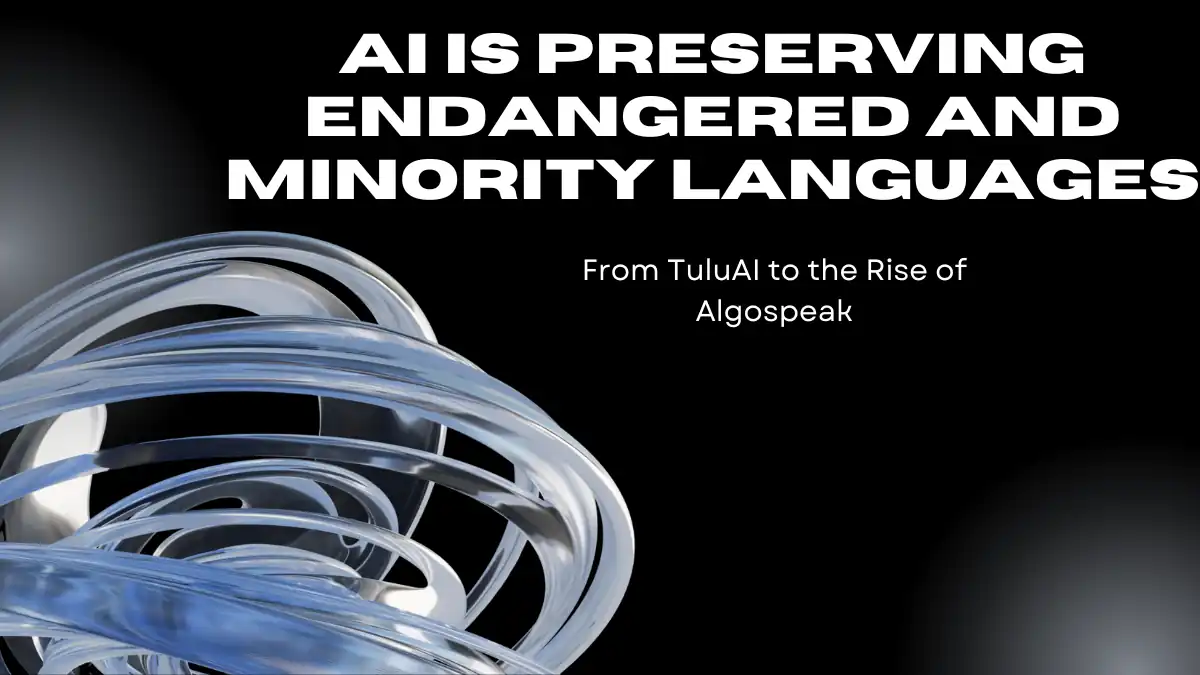AI is Preserving Endangered and Minority Languages: From TuluAI to the Rise of Algospeak
The accelerating pace of globalization and technological advancement
poses a significant threat to linguistic diversity. As dominant languages
spread, numerous smaller, indigenous, and minority languages face the risk of
extinction, taking with them unique cultural perspectives and knowledge
systems. However, a powerful ally has emerged in this struggle: artificial
intelligence. From sophisticated translation tools to innovative language
learning platforms, AI offers unprecedented opportunities to document,
revitalize, and safeguard endangered languages. But this technological
intervention also introduces new complexities, as seen with the rise of
"Algospeak" and the potential for AI to subtly shape linguistic
evolution.
The Promise of AI in Language Preservation
AI and language preservation efforts are inextricably linked. Protecting endangered languages requires robust digital tools for language survival. Traditionally, language preservation relied on painstaking manual efforts: recording native speakers, compiling dictionaries, and developing grammars. These processes were often time-consuming and resource-intensive. AI streamlines these tasks, making them more efficient and scalable.
One of the most significant contributions of AI is in the field of translation. AI-powered translation for rare languages facilitates communication and understanding between speakers of minority languages and the wider world. Tools like machine translation can rapidly translate texts and speech, enabling access to information and resources that were previously unavailable. This is particularly crucial for preserving indigenous languages with AI, where access to educational materials and online content can be limited.
Furthermore, AI algorithms can analyze language data to identify
patterns and structures that might otherwise be overlooked. This can be
invaluable in developing grammars and dictionaries for languages that have not
been thoroughly documented. By analyzing audio recordings of native speakers,
AI can automatically transcribe speech, identify key vocabulary, and even
generate synthetic speech in the target language.
The TuluAI project
The TuluAI project serves as a compelling example of AI's potential. Tulu, a Dravidian language spoken in South India, is classified as vulnerable by UNESCO. The TuluAI initiative aims to create a comprehensive digital archive of Tulu language and culture, using AI to transcribe, translate, and analyze Tulu texts and audio recordings. This project not only preserves the language but also makes it more accessible to younger generations, who may be more comfortable interacting with technology than with traditional methods of language learning.
The Double-Edged Sword:
Algospeak and AI-Driven Language Change
While AI offers immense potential for language preservation, it also presents certain challenges. One notable phenomenon is the rise of "Algospeak," a term used to describe the intentional modification of language to avoid detection by content moderation algorithms on social media platforms.
Algospeak involves using euphemisms, misspellings, and coded language to discuss sensitive topics without triggering automated filters. While Algospeak can be seen as a form of digital resistance, it also has the potential to fragment language and create new barriers to communication. The AI driven language change, although unintentional, can change linguistic trends in the AI era.
Moreover, the use of AI in language translation and content creation can inadvertently influence the way languages evolve. Machine translation algorithms are trained on vast datasets of text and speech, which may reflect certain biases or preferences. If these biases are not carefully addressed, they can be perpetuated and amplified by AI, leading to the homogenization of language and the suppression of linguistic diversity. This requires a thoughtful approach to AI development and deployment, with a focus on fairness, transparency, and inclusivity.
Navigating the Future of Language Diversity
The intersection of AI and language preservation is a complex and evolving field. To harness the full potential of AI for protecting endangered languages while mitigating the risks, several key steps are needed.
First, it is essential to prioritize the development of AI tools that are specifically tailored to the needs of minority language communities. This requires close collaboration between linguists, technologists, and native speakers to ensure that the tools are culturally appropriate and linguistically accurate.
Second, efforts should be made to promote the use of AI in language education and revitalization programs. By creating engaging and interactive learning experiences, AI can help to spark interest in endangered languages among younger generations and encourage them to become fluent speakers.
Third, it is crucial to address the ethical implications of AI in language processing. This includes ensuring that machine translation algorithms are free from bias and that AI-generated content accurately reflects the nuances of different languages and cultures.
Finally, ongoing research is needed to understand the long-term impact of AI on language evolution and to develop strategies for mitigating any negative effects. By carefully monitoring linguistic trends and adapting our approach to AI development, we can ensure that technology serves as a force for preserving and celebrating linguistic diversity.
Conclusion
AI offers both unprecedented opportunities and potential challenges for
the preservation of endangered and minority languages. From TuluAI to the rise
of Algospeak, the interplay between technology and language is reshaping the
linguistic landscape. By adopting a thoughtful and ethical approach to AI
development, we can harness its power to safeguard linguistic diversity and
ensure that future generations have access to the rich cultural heritage
embodied in the world's languages. The future of language diversity hinges on
our ability to navigate this complex terrain with wisdom and foresight, using
AI as a tool for empowerment and preservation, not homogenization.


0 تعليقات